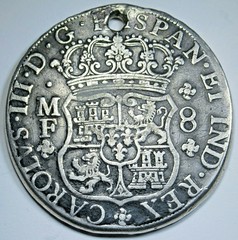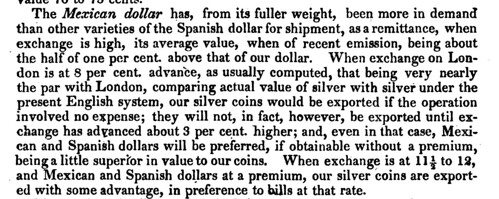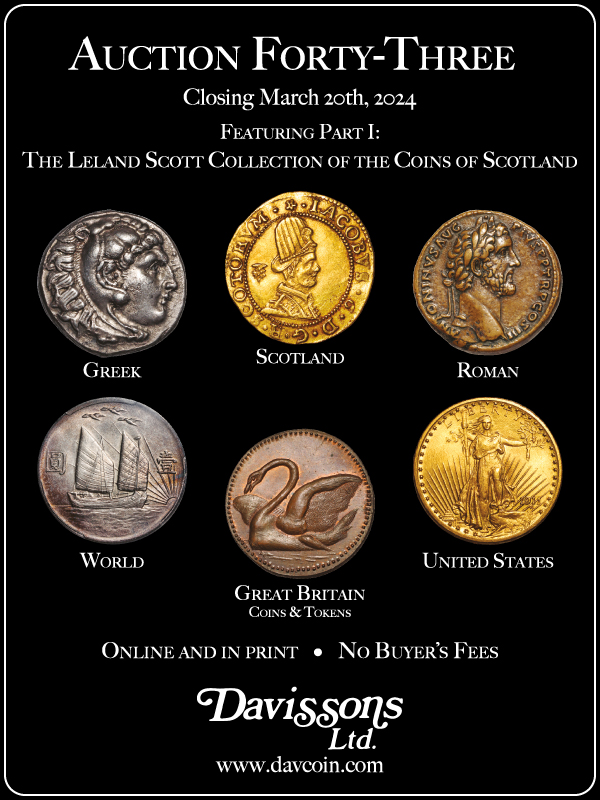
PREV ARTICLE
NEXT ARTICLE
FULL ISSUE
PREV FULL ISSUE
MORE ON THE SPANISH-U.S. DOLLAR TRADECraig Sholley and Harry Salyards submitted these additional notes on the fineness of the silver in early U.S. coinage and the exchange of U.S. silver dollars for Spanish dollars. -Editor More On The Spanish Dollar-U.S. Dollar Trade
Of particular interest to the subject at hand, is Wolcott's specific mention of the The fact that Wolcott specifically cited the act truly cements our contention that few, if any, of the Spanish dollars deposited by the bank in 1800 through 1805 were full-weight, since doing so would have violated the Secretary's directive. In fact, in order to comply with the directive, the Spanish dollars deposited by the bank must have weighed less than 415 grains. So, even if one proposes that the dollars deposited weighed, on average, 414.5 grains, since they assayed at .8924 to .8934, the dollars, on average, would have contained just 369.89 to 370.13 grains of silver – that's less than the 371.25 grains of silver in a U.S. dollar!
Since the Bank of the United States was the only entity depositing any significant quantity of
Spanish dollars prior to 1806, the fact that the dollars deposited actually contained less silver
than a U.S. dollar simply destroys the myth that huge numbers of U.S. dollars were exchanged
for It could be suggested that the supposed dollar-for-dollar arbitrage trade story became muddled over time and what really took place was a trade of two U.S. half dollars for Spanish dollars from 1806 on, when there were numerous large deposits of Spanish dollars by several entities. Or it could be suggested that U.S. banks had hoarded U.S. dollars as specie backing for loans until 1806 and the trade actually took place then.
No matter, the tale still does not work since the Spanish colonial dollars deposited from 1806
through 1810 or so, all assayed at a maximum of .8957 fine. So, even if the Spanish dollars
deposited in 1806 on all weighed the full standard of 417.7 grains, they contained just 374
grains of pure silver. That is less than eight-tenths of a percent more than the 371.25 grains of
silver in a dollar's worth of U.S. coins - far too little to cover the shipping and insurance costs of
the trade, not to mention what an
In fact, it is not until well into the period of the First Mexican Republic that the Mexican dollars
were of a weight and fineness consistent enough to permit this mythical trade and that is well
after the story first appears in 1831. In sum, the storied Craig Sholley adds:
I would love to know how this tale got started. Harry found the ref to a version of the tale appearing in 1831 and Eckfeldt and Dubois alluded to it in their 1842 tome (see page 83, where they state, So, it does appear to be a "mint myth" by at least the early 1830s. It may have its genesis in the 1829 "report where Moore discusses which coinage is preferred for international trade."
Report from the Secretary of the Treasury Respecting the relative value of Gold and Silver. &c. May 29, 1830 Craig continues: This whole subject is absolutely fascinating. Like most, I had simply read what Taxay wrote (pg. 125) and took it for granted. Geez, the guy had access to the mint and records. Why not believe him? It was Harry who emailed me pointing out that if there was this trade going on, then where were all the deposits of Spanish dollars when USD were actually being struck? Unless one counts deposits shown as "Coins of Spain," there are none prior to 1800 and not much through 1805. Even if the "Coins of Spain" deposits are counted as Spanish dollars (which is doubtful given the assays), they don't amount to much more than 20K - hardly a massive trade. So, just looking at the quantity of supposed Spanish dollars deposited through 1805, the story makes no sense. And, once we started calculating the fineness, the story made even less sense. This story certainly should have questioned much sooner since it makes little sense economically or logistically. First, what merchant is gonna send USD to the West Indies for exchange with a supposedly heavier SD and make just one percent or so after expenses when buying goods like rum, molasses, sugar, spices, tobacco, etc. would yield a far higher profit? Further, whomever was doing the supposed trade would have to make sure that the SDs weighed at least 417 grains on average and assayed above .900 or the difference in pure silver would not be great enough to cover the costs of return shipping, insurance, and someone to gather and check the SDs. And, since a full assay would be necessary to ensure the proper amount of silver, the coins would be returned as ingot, not SDs. Since, the trade also needs to cover assay costs, there really was no profit to be had even if the coins were full-weight at 417.7 grains and really did contain 377 grains of pure silver. While there are deposits of "ingots" by private merchants such as John Vaughan and James Swann, the assays are "all over the place" from .879 to .998. Thus, the ingots deposited were agglomerations of various forms of silver accumulated by merchants and banks for use in international trade, specie backing of bonds and bills, and/or waiting for the mint to commence coining. The real shame in all of this was the impugning of Hamilton. Here's a guy that turned out to be the financial genius who figured a way to pay the war debt without bankrupting the country. Nonetheless, for the past 150 years he's been labeled as an unknowledgeable guy who got fooled by "bad assays" and misassumptions about the world gold-to-silver ratio, and thus chose the "wrong" standard for our early coinage. And most of us accepted these tales without one iota of proof. Shame on us.
To read the earlier E-Sylum articles, see:
Wayne Homren, Editor The Numismatic Bibliomania Society is a non-profit organization promoting numismatic literature. See our web site at coinbooks.org. To submit items for publication in The E-Sylum, write to the Editor at this address: whomren@gmail.com To subscribe go to: https://my.binhost.com/lists/listinfo/esylum All Rights Reserved. NBS Home Page Contact the NBS webmaster 
|


